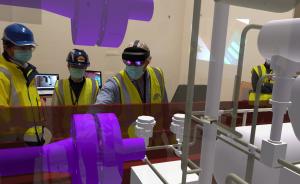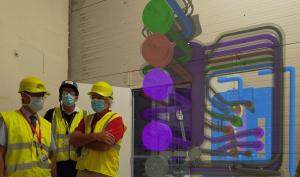Assessing the future work environment
As part of their collaboration within the Site Support Agreement*, ITER and its neighbour CEA are developing a novel approach to explore, analyze and assess the work environment in the port cells dedicated to the handling of the test blanket modules. By virtually superimposing 3D models on the world as it is, "augmented reality" tools not only provide an awesome experience but they can contribute to maximizing operator efficiency while minimizing their exposure.
Test blanket modules are essential to the future of fusion energy, which rests on the capacity of future industrial reactors to breed tritium—one of the two hydrogen isotopes (with deuterium) involved in the fusion reaction. While tritium occurs naturally only in trace amounts, a certain type of fission reactor (CANDU) generates minute quantities of tritium that accumulate into a global inventory that hovers around a few dozen kilograms. Over its years of full-power operation, ITER will consume the totality of the tritium available worldwide, but will also prepare for the future by implementing experimental "tritium-breeding modules."
Two pairs of test blanket modules, developed and procured by the ITER Members and each implementing a specific technology, will be embedded into the inner wall of the vacuum vessel. Although the active, plasma-facing element of each breeding module is a relatively small component (1.7 metres tall and 60 centimetres wide), they are part of a much larger structure that weighs close to 45 tonnes.
Every other year, during shut down, two massive structures (each holding two test blanket modules), will need to be extracted so that the plasma-facing elements can be submitted to in-depth analysis.
At Level 1 of the Tokamak Building, which corresponds to the equatorial region of the machine, two "ports" are dedicated to the handling of test blanket systems and will be used as entry and exit passages for the 45-tonne components. Today they are empty, but when the machine is operational they will be crowded with a forest of pipes, ducts, rails and systems of all kinds.
Although most of the handling operations will be performed automatically and remotely, human intervention will be required at some points. But as the ports stand close to the machine and will have been exposed to burning plasmas for several months, the presence of duly equipped operators will have to be limited and their exposure time reduced to a minimum.
The test blanket systems, which will be installed a few years before full-power operation begins, are presently in the preliminary design phase. "We have drawings, we have 3D models, but in order to optimize our approach, we need more," explains Jean-Pierre Martins, the maintenance engineer in the ITER Tritium Breeding Blanket System section.
The "more" is a novel approach developed by CEA experts and called "augmented" or "extended" reality. It feeds from 3D databases to create an "in-context" immersion, blending and superimposing virtual and "real" elements such as doors, walls and galleries. System designers, experts and decision makers—each wearing a state-of-art headset (such as Microsoft HoloLens)—can participate in the same simulation, exploring the physical configuration of the projected port cell environment and sharing a common understanding of the working configuration and conditions.
The experience is awesome: through the hologram that is projected onto the eye's retinae, the operators are walking through the densely packed environment of that port cell as it is planned and experiencing the challenges that they will encounter.
Understanding the constraints that the environment will impose is essential to optimizing their interventions. "We are aiming for maximum efficiency and minimum exposure, in line with the ALARA principle (As Low As Reasonably Achievable) that governs radiation exposure in nuclear environments," says Martins. "In this perspective, when implemented at the early phase of a system's design augmented reality is an extremely promising tool. Beyond its application to the test blanket module system, it can be propagated to the entire project."
These past weeks the ITER Director-General, the Heads of Domain, and several managers have donned the magic headset, ventured into the strange world where real and virtual blend, and taken the full measure of augmented reality's potential in planning for the future.
Click here to view a video of the trials.
* Signed in 2009, the Site Support Agreement establishes and defines the relationship between the ITER Organization, the French Commissariat à l'énergie atomique et aux énergies alternatives (CEA) and Agence Iter-France.




